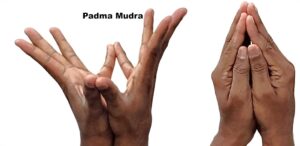Padma Mudra (Lotus Gesture)
Introduction
Padma Mudra is a sacred hand gesture symbolizing purity, love, and spiritual awakening. In yogic traditions, the lotus (Padma) represents beauty and purity emerging from the mud, untouched by impurities. This mudra is deeply connected with the heart center (Anahata chakra), promoting openness, compassion, and spiritual blossoming.
It is often practiced in Bhakti yoga, meditation, and pranayama to cultivate devotion, inner beauty, and divine connection.
Meaning
Padma = Lotus (a symbol of purity, love, and enlightenment).
Mudra = Seal, gesture, or psychic lock.
Thus, Padma Mudra means “Lotus Gesture”, representing the unfolding of the heart and spiritual consciousness, much like a lotus opening to the sun.
How to Perform Practice
Step-by-Step
Sit in a comfortable meditative posture (Padmasana, Sukhasana, or Vajrasana).
Bring both hands together in front of the chest in Namaskar Mudra (Anjali Mudra).
Place your palms and fingers flat against each other in front of your energetic heart centre (against your breastbone).
Slowly bend your knuckles and allow your fingers to bow outward, keeping the lower portion of your palms together as well as the tips of your fingers.
Now bring the edges of your little fingers and thumbs together as you slowly stretch your other fingers wide.
Benefits
Physical Benefits
Opens the chest and improves lung capacity.
Enhances circulation in arms, wrists, and fingers.
Relieves tension in the chest and shoulders.
Mental & Emotional Benefits
Cultivates love, compassion, and emotional openness.
Helps release grief, anger, and resentment.
Reduces stress, anxiety, and emotional fatigue.
Promotes self-love and acceptance.
Spiritual Benefits
Awakens Anahata Chakra (Heart Center).
Encourages devotion, gratitude, and higher love.
Symbolizes spiritual awakening and purity.
Used as a gesture of offering and surrender in meditation and ritual practices.
Contraindications
Generally safe with no major physical risks.
People with severe wrist pain or arthritis may find the hand position uncomfortable.
If emotionally overwhelmed, practice gradually to avoid over-sensitivity.
Anatomy & Physiology
Expands the thoracic cavity, improving respiration.
Stimulates the parasympathetic nervous system for relaxation.
Opens the heart region → enhances cardiac function and circulation.
Engages finger extensors and forearm muscles for gentle activation.
Kinesiology
Requires flexion at the metacarpophalangeal joints of thumbs and little fingers (to touch).
Abduction of the other three fingers creates expansion and openness.
Shoulder and chest opening encourages proper spinal alignment.
Promotes balance between muscle contraction and expansion in the upper body.
Neurology
Stimulates brain regions related to empathy, love, and compassion.
Activates the limbic system, calming fear and emotional distress.
Balances right-left hemispheric activity → improves harmony between logic and intuition.
Supports heart-brain coherence (emotional regulation + calm focus).
Duration of Mudra
Beginners: 5–10 minutes during meditation or pranayama.
Intermediate: 15–20 minutes daily for emotional healing.
Advanced: Up to 30–45 minutes, especially during mantra chanting (e.g., chanting “Om Mani Padme Hum”).
Counter Mudra
Hridaya Mudra – for emotional balance and releasing heaviness from the heart.
Anjali Mudra – for centering and grounding.
Apana Vayu Mudra – to restore energy after deep emotional release.
Conclusion
Padma Mudra is a gesture of purity, love, and heart awakening. Like the lotus that rises unstained from muddy waters, it teaches us to rise above negativity and open to higher consciousness. It is especially useful in meditation, Bhakti yoga, and healing practices to release emotional burdens and cultivate compassion. Regular practice deepens heart-centered awareness, making it a powerful tool for both inner peace and spiritual growth.
FAQ
Q1: Which chakra does Padma Mudra activate?
Primarily the Anahata (Heart Chakra).
Q2: Can Padma Mudra be done during pranayama?
Yes, it enhances the effects of Anulom Vilom (alternate nostril breathing) and meditative breathing.
Q3: Is it related to any deity?
Yes, the lotus is associated with Lakshmi (goddess of abundance) and Avalokiteshvara (Bodhisattva of compassion).
Q4: Can beginners practice this mudra?
Absolutely. It is safe, simple, and deeply effective for all levels.
Q5: What is the best time to practice?
Morning meditation or evening relaxation is ideal, but it can be practiced anytime for emotional balance.
References
Swami Satyananda Saraswati – Asana, Pranayama, Mudra, Bandha
Indu Arora – Mudra: The Sacred Secret
Swami Niranjanananda Saraswati – Yoga in Daily Life
Gertrud Hirschi – Mudras: Yoga in Your Hands
B.K.S. Iyengar – Light on Yoga

